Casey Street and Public Art

The City of Casey has a significant Public Art program which uses art to create meaningful places that celebrate the city's community, heritage, innovation and environment. The art work includes:
Berwick
Eel Seat by Julie Squires, Ursula Dutkiewicz with community members from City of Casey

The Eel Seat is designed as a visual collection of images based on the surrounding wetlands and community uses of the Reserve. The images on top of the work were created directly by community members who attended workshops at the Pavilion.
Location: Clyde Road Reserve, 21 Grices Road, Berwick (near playground)
Forest Seat by Anuradha Patel
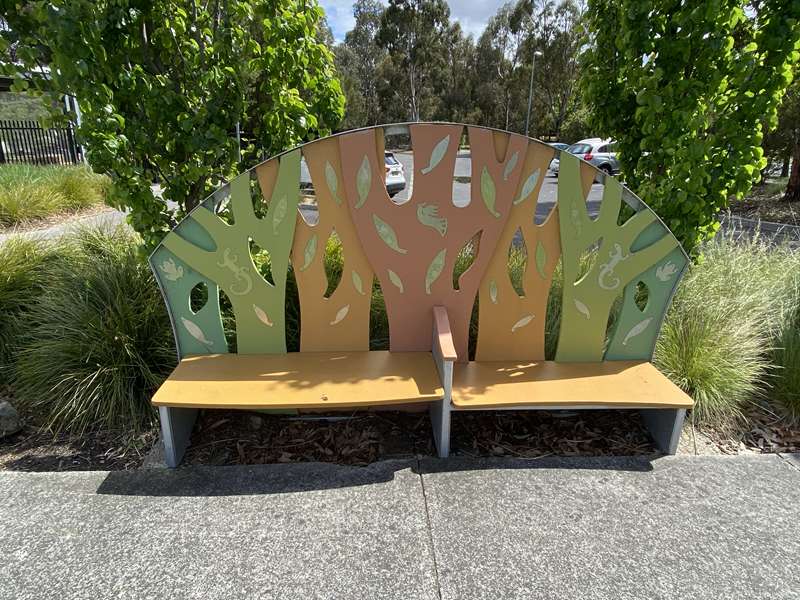
A forest is a place of mystery and adventure. This seat, created by Anuradha Patel, is inspired by the vivid imaginations and dedicated love of nature which is demonstrated by the children who attend this centre. The motifs on the seat reflect items found in the children's collections and their drawings.
Location: Bridgewater Family and Community Centre, 45 Bridgewater Boulevard, Berwick
Acrylic Wall Installation
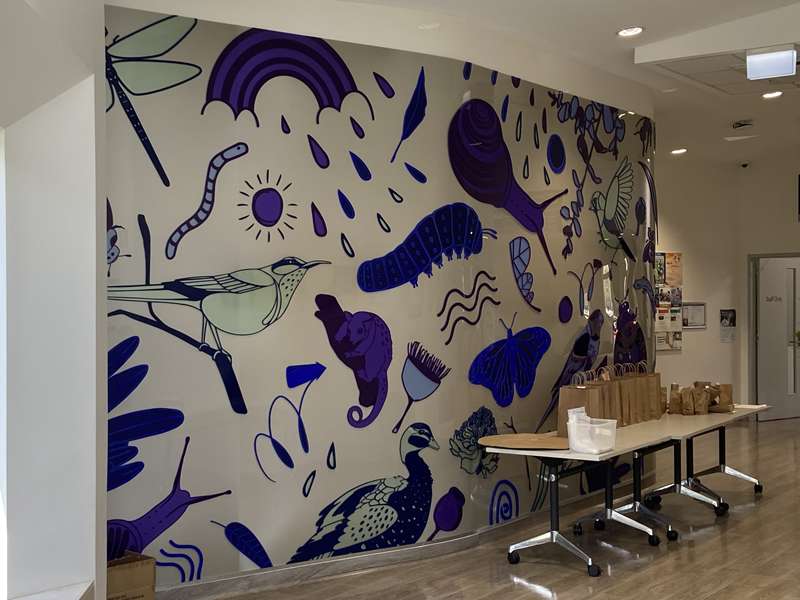
Untitled acrylic wall installation.
Location: Bridgewater Family and Community Centre, 45 Bridgewater Boulevard, Berwick
Maple Leaf by Rudi Jass
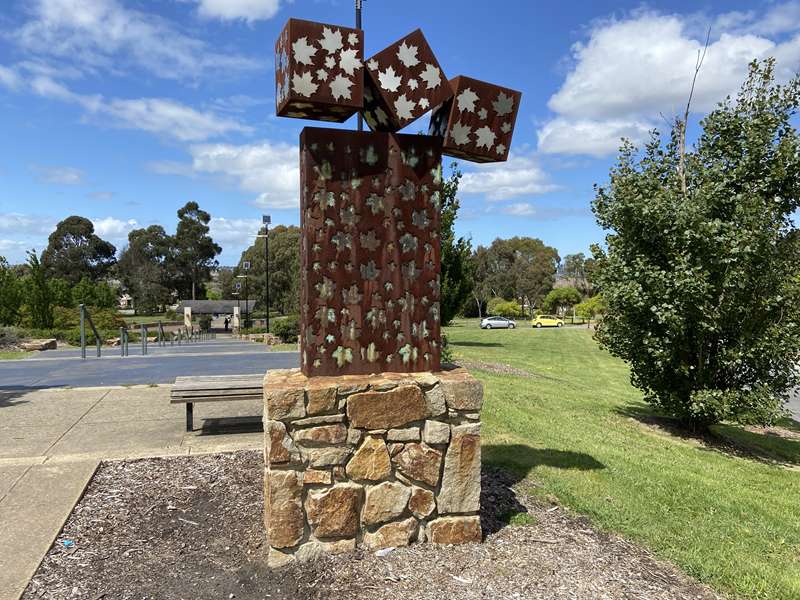
Free standing steel sculpture with relief pattern.
Location: Cnr Bridgewater Boulevard and Myoora Place, Berwick
Walkway Arbour (Avenue) by Rudi Jass
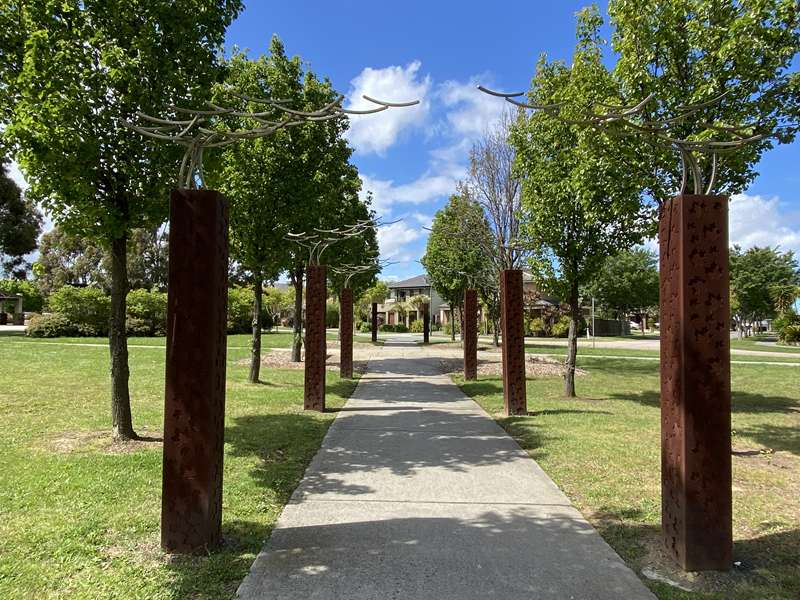
Arbour formed by treelike metal posts.
Location: Wurundjeri Boulevard Reserve, 54 Wurundjeri Boulevard, Berwick (west of basketball court)
Beyond First Glance by Anne Riggs (2010)
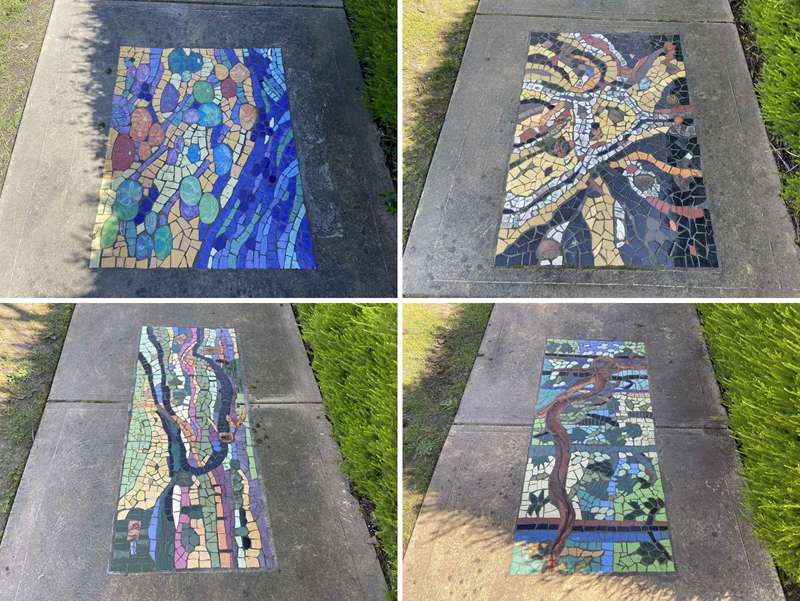
This series of five stunning mosaics feature marble and handmade tiles by the artist. Depict elements from the natural environment, the works span the entrance to the children's centre, offering a gallery of surprises as viewers are encouraged to look beyond the first glance to discover a myriad of hidden details.
Location: Gwendoline Childrens Centre, 25 Gwendoline Drive, Berwick
Edwin Flack Statue by Peter Charles Williams (1996)
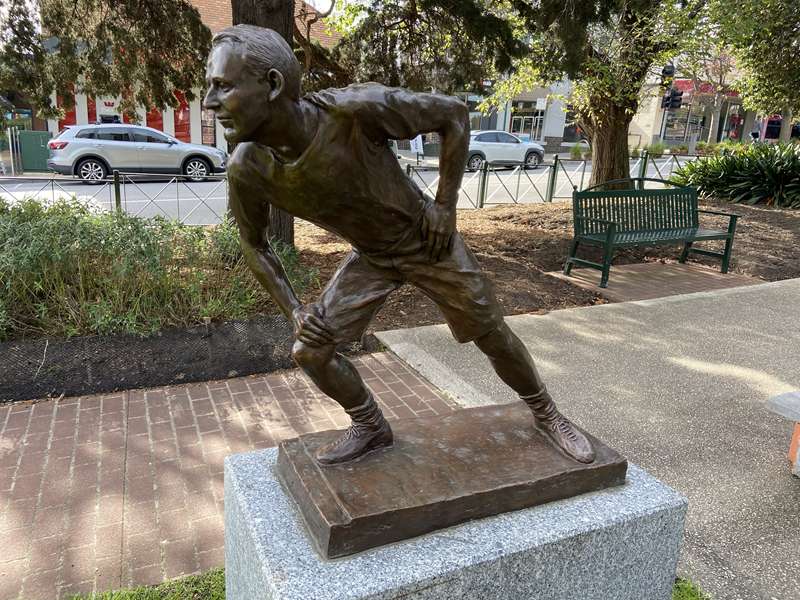
A bronze half life-size statue of Edwin H. Flack, who was Australia's first Olympic gold medalist.
Edwin Flack was the sole Australian to compete in the first Modern Olympic Games in 1896 at Athens Greece. Flack took part in five events 800m, 1500m, and the marathon (athletics) and in the tennis (singles & doubles). Flack was successful in winning the 800m and 1500m events.
Edwin Flack was an accountant and lived in Melbourne. Berwick however was Flack's second home as he owned the farming property "Burnbank" located between Beaumont and Buchanan Roads. On this property with his partners Sir Sydney Sewell and later William Gamble, Flack established a most successful Friesian dairy herd from which he produced milk and cheese.
Edwin Flack was born in England in 1873, immigrated with his family to Australia in 1878, and following an eventful life died in 1935. Flack never married. Many charitable and welfare organizations, hospitals and research funds have benefited from his estate. He was buried at the Berwick Cemetery.
Location: 80 High Street, Berwick
Spyridon Louis Statue by Michael Meszaros
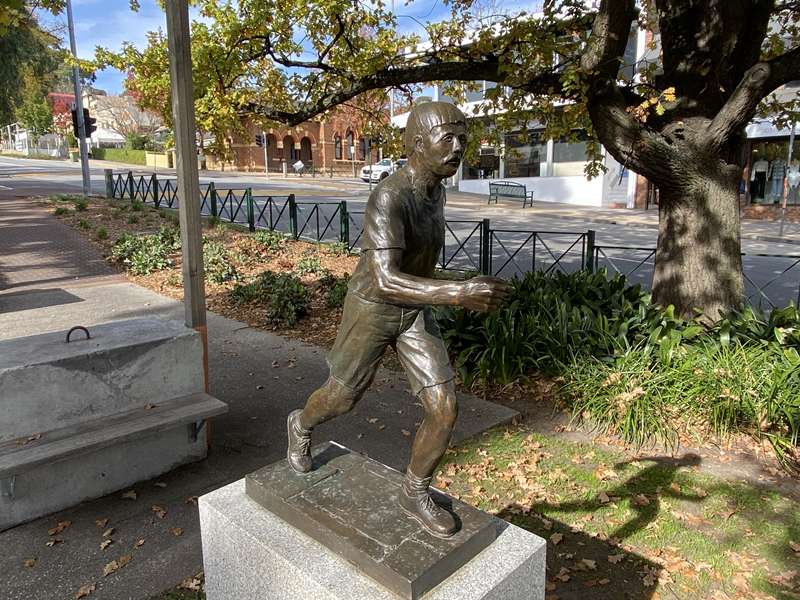
Spyridon "Spyros" Louis, 12 January 1873 - 26 March 1940.
Spyridon Louis was modern Greece's first Olympic gold medallist at the 1896 Olympics in Athens, Greece.
Spyridon Louis and local athlete Edwin Flack competed against each other in the Men's marathon at the Summer Olympics, with Louis recording a winning time of 2:58:50. Despite the acclaim, louis never raced again, instead returning to his village of Amarousi, Greece, where he worked as a shepherd and seller of mineral water.
Australia and Greece are the only countries to have participated in every modern Olympics since 1896. This statue was erected in recognition of the friendship between Louis and Flack and the proud Olympic heritage that Australia and Greece share.
Location: 80 High Street, Berwick
Statue of Lord Richard Casey by Louis Laumen
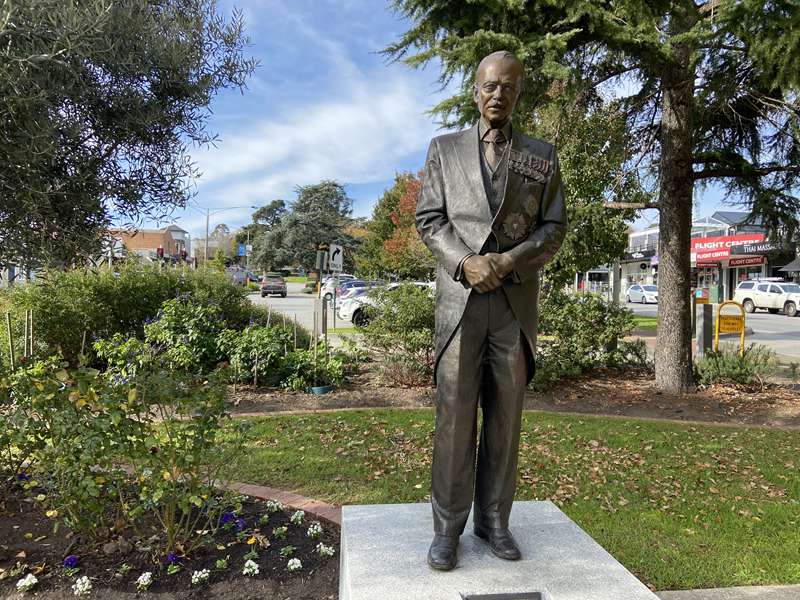
Lord Richard Gavin Gardiner Casey, soldier, politician and the man the City of Casey was named after, has been honoured with a bronze statue on High Street in Berwick.
Location: 42 High Street, Berwick
War Memorial Lions by unknown artist
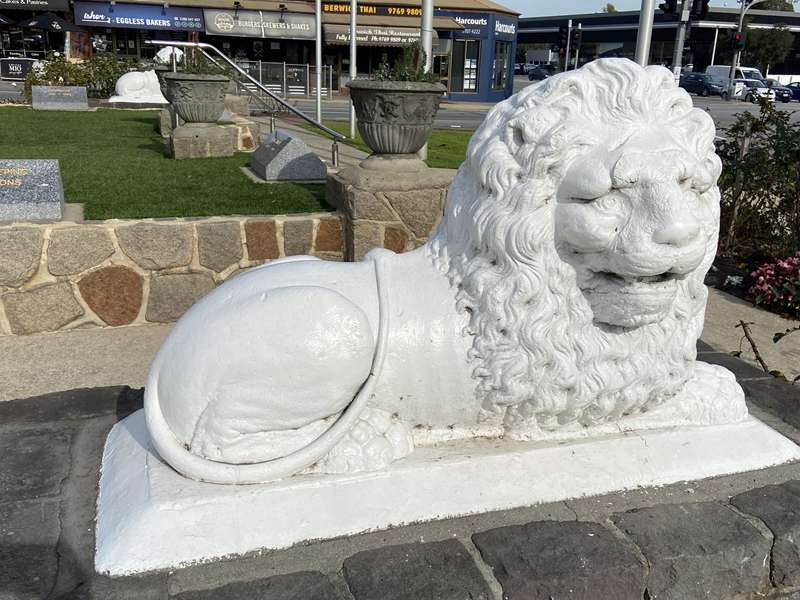
There are two lions near the War Memorial in the centre of High Street in Berwick. In the late 1970s the Brentwood Housing Estate on the Rowden land was started and the lions were moved to High Street from Brentwood around 1985.
Location: 34 High Street, Berwick
Still Moment by Will Georgiev
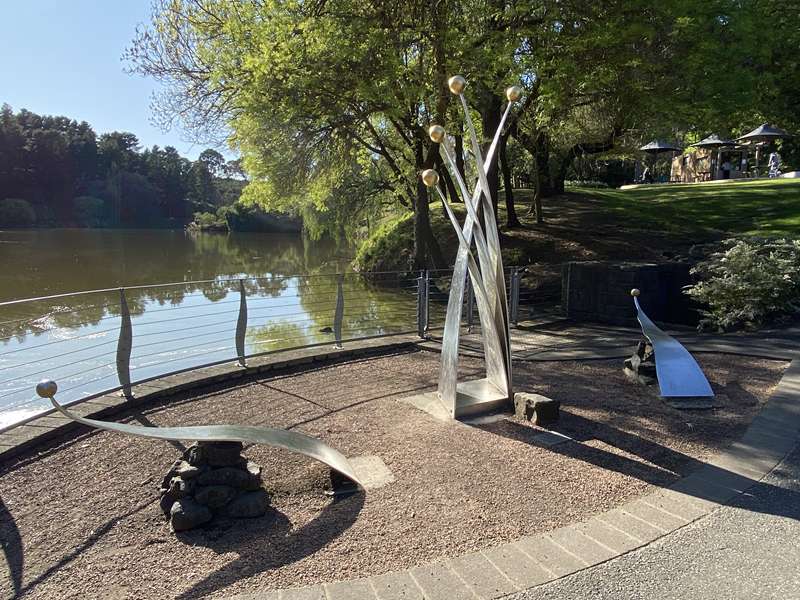
This artwork designed by Zabelski Ham sculptors, is inspired by the natural environment, the spread of feathers in a bird's wing, the movement of leaves in the wind and of people as they journey through Wilson Botanic Park. 2007.
Location: Wilson Botanic Park, Cnr Princes Hwy and Coniston Ave, Berwick
Seed by Rudi Jass
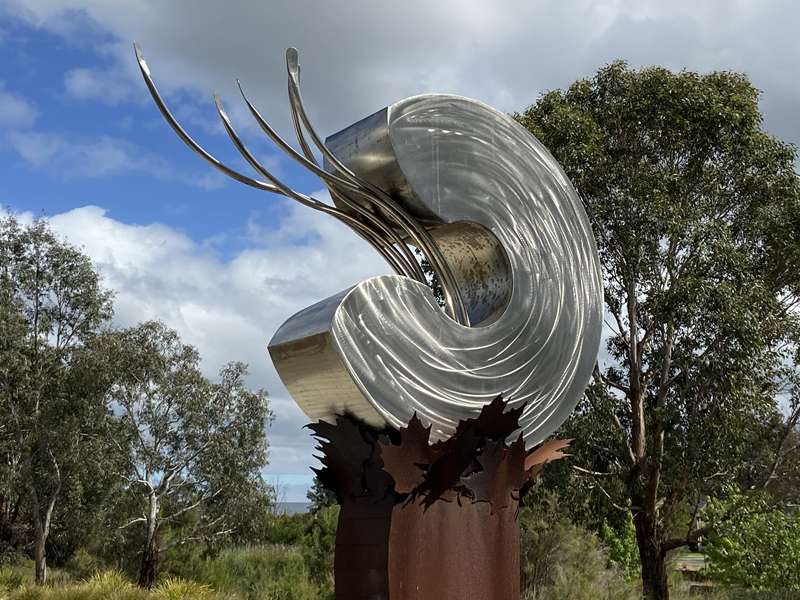
Stainless 'C' letter on top of rusted steel supporting structure (to represent a seed)
Location: Cnr Grices Road and Kirrabilli Parade, Berwick
Akoonah Park Painted Bollards
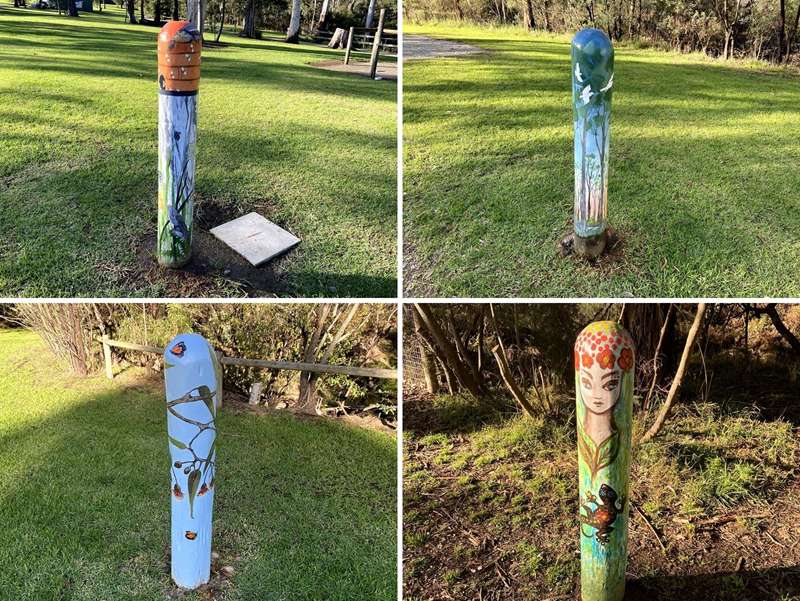
A number of painted bollards around the SECAN gallery beside Cardinia Creek. There is also some ceramic artwork around the the SECAN gallery.
Location: 6 Cardinia Street, Berwick
Clyde
8t Wheel Barrow

One of the more unusual playgrounds / artworks is the 8 tonne Wheel Barrow. The whimsical urban art installation plays on the Hartleigh estate's past as a vegetable market garden and is super-sized it so won't get lost against the 5ha wetland reserve adjoining it. There is a birds nest swing hanging off one of the handles.
Location: Aintree Close, Clyde
Clyde North
Mick Morland Reserve Bird Sculpture by Deborah Halpern
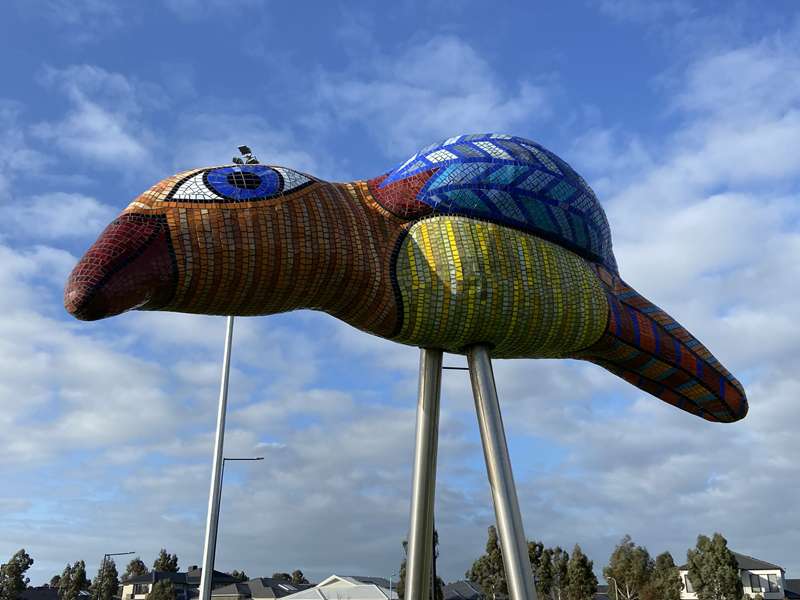
The reserve is dedicated to long-serving City of Casey councilor Mick Morland who tragically died when struck by a car in 2017.
Location: Mick Morland Reserve, Copabella Circuit, Clyde North
Birds with Headphones Sculpture by Anderson Hunt
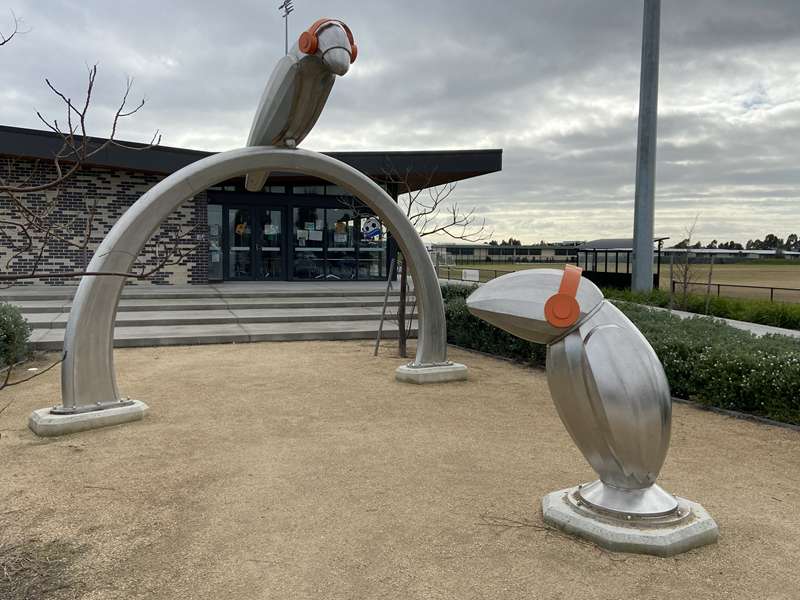
Location: Selandra Reserve, 25 Aayana Street, Clyde North
Club Delaray Artwork

Location: 66 Deoro Parade, Clyde North (outside Club Delaray)
Touchstone by Jordan Lacey
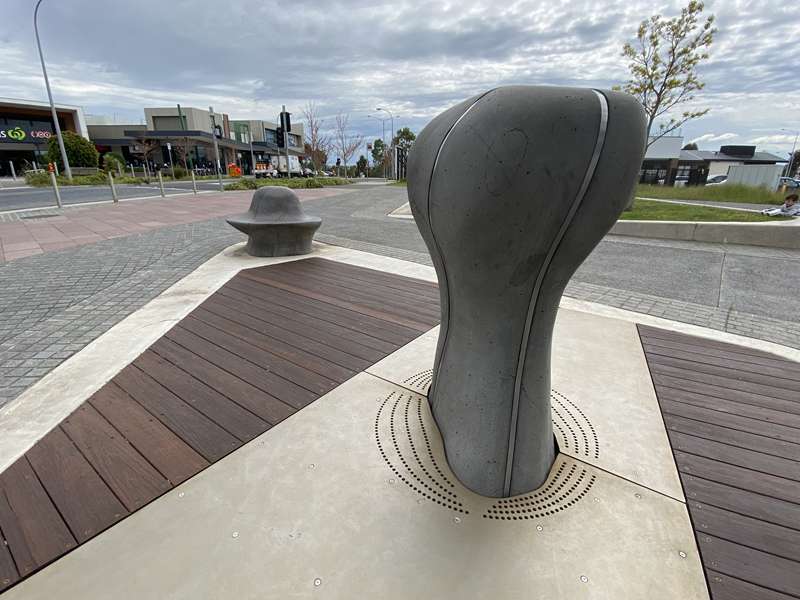
The work may be understood as an extended system of affective materialities; an unusual mix of solidity and ephemerality in which the user's interactions temporarily form an experiential interconnection between ground, self and sky.
Location: Selandra Community Hub, 9 Selandra Boulevard, Clyde North
Spirit of Community by Col Henry (2015)

The brief called for an iconic work that would resonate with the Community around Selandra Rise Community Centre. Commissioned by Casey Council, the work uses as its main symbolic reference, the concept of growth in this new and developing area. The Centre has a large attendance from young children, and the four horizontal elements are designed to engage the children, while they explore the meanings and symbolic referenced embedded in the work. The right hand image shows the work just after installation and before the lawn was installed.
The four 'PLAY' elements are named, Uluru, The Peanut, The Slippery Slide and The Cove.
These low lying works average approximately 1.5 meters long and are filled with concrete to allow a robust interaction with the users of the facility. The 'Mirror Polished' organically formed 'stripes' embedded on the 'Satin Polished' surfaces, represent the 'Journeys that people take during their lives', and reinforces the concept of 'Coming together as a Community', building in strength and potential.
The Main vertical feature is over 5 meters tall, and has LED lighting, and symbols sourced from the Pre School and Playgroup participants. These delightfully naive symbols are of their family members, and add a 'local' site specific connection. The works are fabricated from several types of high quality stainless steel, including a stainless steel that has a unique and robust patina often mistaken for wood or rusted steel, developed by the Artist over many years.
Location: Selandra Rise Family & Children's Centre, 45 Haflinger Avenue, Clyde North
Tree by Folko Kooper

'Tree' is a contemporary sculpture of abstract design. Upon approach, the tree reveals itself in two parts, with the canopy embracing a single owl. The two parts (him & her) (night & day) hold aloft the owl, the ancient Greek symbol of learning and intelligence. The tree is a powerful symbol for the embracing of culture and tolerance.
Location: Delaray Park, Cnr Deoro Parade and Brookhouse Street, Clyde North
Delaray Waters Wetland Swan

Location: Cnr Heather Grove and Domingo Avenue, Clyde North (outside Club Delaray)
Shard Series 8 & 9 by Benjamin Gilbert

Inspired by the historic meteor event known as the Cranbourne Meteors.
Location: Along Newbridge Boulevard, Clyde North
Ramlegh Reserve Sculpture
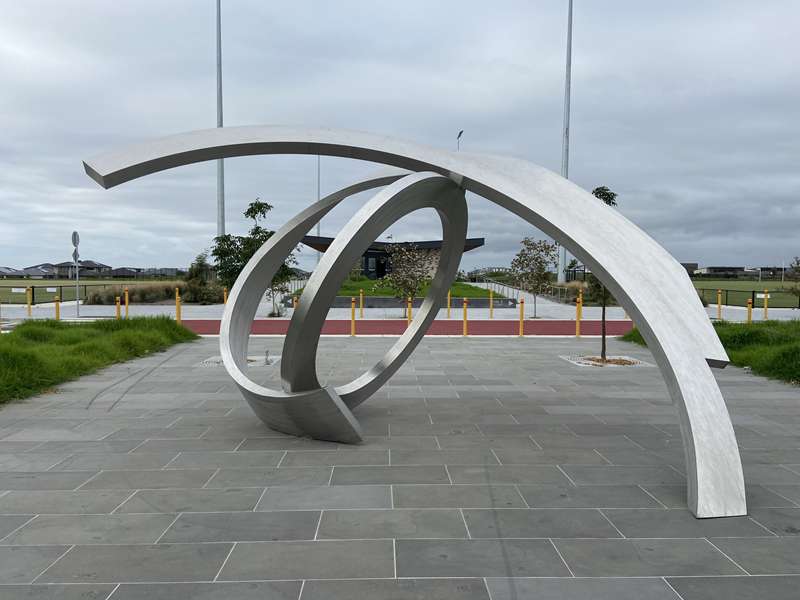
Location: Ramlegh Reserve, 251 Heather Grove, Clyde North
Location: Along Newbridge Boulevard, Clyde North
Bloom Pods Sculpture by Matthew Harding. Fabricated by Artisan Engineering.
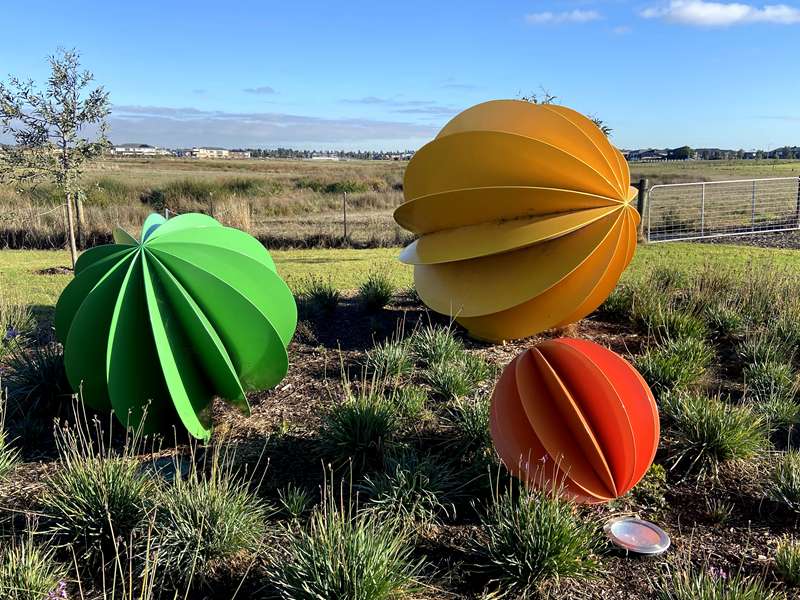
Location: Near playground at corner Tartan Drive and Gator Esplanade, Clyde North
Acacia Seed Sculpture by Matthew Harding. Fabricated by Artisan Engineering.
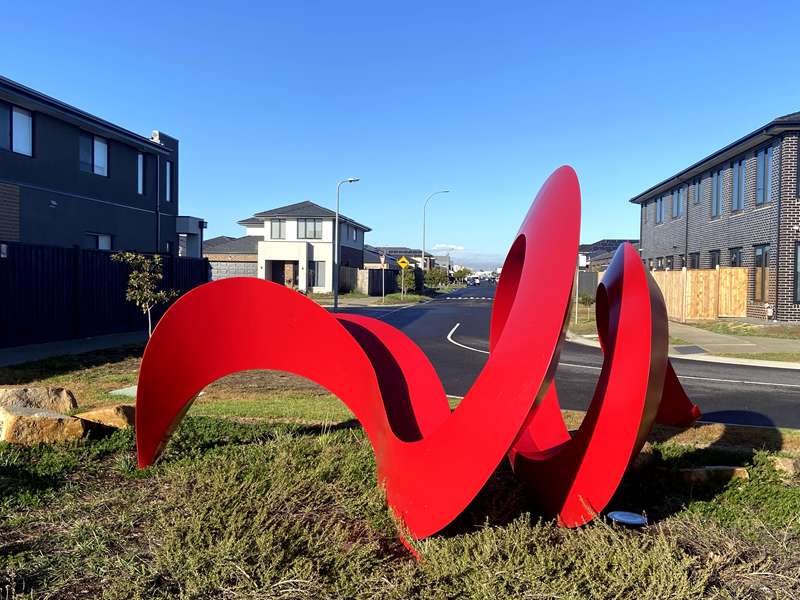
Location: Near corner Tartan Drive and Gator Esplanade, Clyde North
Cranbourne
eXert by Jonathan Leahey (2016)

Muscle is the driving factor in this kinetic sculpture it is based on human movement. eXert is inspired by muscle and tendon systems that enable our existence. It is an interactive exploration into physical movement at 10m high this installation creates a local sports identity - eXert is unique, kinetic, self sustainable. Observable from a distance, engaging robust and accessible to the casual observer but inviting deeper consideration on a more complex conceptual level over time.
Location: Carlisle Park, 20 Majestic Boulevard, Cranbourne
Paying Homage by Yvonne George (2008)

Paying Homage depicts the land in times of drought; the cracked earth, the bare tree with leaves fallen. This is what nature does to preserve life for the tree in times of a drought. The inspiration for this piece came from looking into a small pool of water in a dam and seeing the reflection of the trees with the parched earth around its edges.
Location: Sierra Estate, Mannavue Boulevard, Cranbourne
English Roach by Mothers Art

This sculpture was originally created by Mothers Art for the 2006 Commonwealth Games in Melbourne. It was one of 72 fish sculptures which featured on the Yarra River as part of the city's spectacular celebrations. Each fish was designed to signify a Commonwealth country.
Location: Inside Casey Recreation & Aquatic Centre, 65 Berwick-Cranbourne Rd, Cranbourne
Cranbourne East
Iron Landscape by Anderson Hunt (2008)

This installation commemorates the landing of the Cranbourne Meteorites; a remarkable phenomena that occurred in Casey which is significant both to Bunurong culture and scientific history. Three iconic steel trees reflect remnant eucalypts, standing as silent reminders of the past. On the edge of the terrace an ancient wetland is transformed by the impact of meteorites, represented by eight cast iron forms.
Location: Casey RACE, 65 Berwick-Cranbourne Road, Cranbourne East
Cultural Ecology of Cranbourne by Adam Magennis (2012)
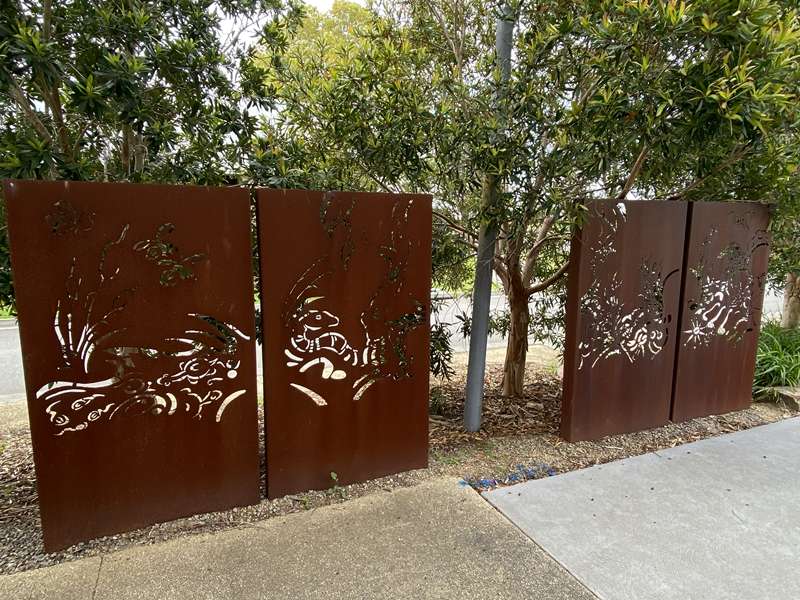
Ten freestanding panels with laser cut designs depicting the local indigenous landscape by Boon Wurrung artist Adam Magennis. It represents a cross section of the important cultural landscape of this region. Two thousand generations of Boon Wurrung/Bunurong and Wurundjeri families gathered here to enjoy the rich natural resources. All the while, Waa (the Australian Raven) and Bunjil (the Wedgetailed Eagle) watch over the landscape as powerful symbols of prestige. What can you see in the landscape?
Panel 01: The rocky uplands are overlooked by Bunjil. The uplands provide stone resources used for tools and building.
Panel 02: Woodlands support and protect natural wildlife and plant systems. Hunter gatherers farm the woodlands by tilling the soil with digging sticks to grow tubers.
Panel 03: Murnong (Yam Daisy) and Orchids are common tuber plants being harvested for food.
Panels 04-07: Wetlands are an important area for natural resources. They provide a protective environment that supports an array of aquatic life. Many permanent and semi-permanent residential sites are located near wetland areas.
Panel 08: Local Eucalyptus species provide fallen hollows for a variety of mammals, birds, reptiles and insects. Leaves, branches and limbs break down over time creating layers of fertile soil.
Panel 09: Areas of fertile land have allowed families to establish themselves in certain locations. Over many generations they leave their marks of occupation on Country.
Panel 10: The uplands provide places for the collection and use of stone tools. Grinding marks within the rocks show favoured sites for cultural practices. Waa looks back over this cultural landscape towards Bunjil.
Location: Balla Balla Community Centre, 65 Berwick-Cranbourne Road, Cranbourne East
Field Landings by Ian Bracegirdle and Mothers Art (2011)

This playful installation brings athletics activities out of the stadium. Oversized javelins protrude from the ground as if they were thrown by a giant athlete. The large steel shot-put pushes aside the earth as it lands creating mounds and ripples.
Location: Casey Fields Regional Athletics Centre, 160 Berwick Cranbourne Road, Cranbourne East
Team Work by Mothers Art (2006)

Team Work is a dynamic sculptural piece designed by Mothers Art Productions for the Casey Fields Complex. Composed of five vertical poles with cross elements, the artwork reflects the spirit of sporting teams as human forms proudly arch their chests and extend their arms around each others' shoulders as they form a tight group.
Location: Casey Fields, 160 Berwick Cranbourne Road, Cranbourne East
Urban Rhythm by Anderson Hunt (2006)

Urban Rhythm was commissioned to complement and celebrate the building of The Factory - Rehearsal centre for the Arts. Created by Anderson Hunt at Down Street Studios, Urban Rhythm reflects the changing landscape of Cranbourne and the movement of energy generated by the performers in the Centre, and is located in the foyer of the building.
Location: Foyer of The Factory Rehearsal Centre for the Arts , 65 Berwick-Cranbourne Road, Cranbourne East
'Thrones of Youth' by Anuradha Patel (2008)

These vibrant seats celebrate the young people of Casey. Over a three year period, 32 young people worked with the artist in all processes of the artwork from the initial research and design to final completion and installation of three seats. The seats were unveiled during National Youth Week in 2008.
Location: The Factory Rehearsal Centre for the Arts, 65 Berwick-Cranbourne Rd, Cranbourne East
FUSE by Natalie Kosnar (2011)

Adorning the entrance to Casey's iconic Shed Skate Park, this dynamic stainless steel design reflects the rhythmic and organic lines created by the movement of riders and skaters. A group of young creative people worked with the artist to develop the design and create their own artworks on skateboards as part of the project.
Location: The Shed Skate Park, 65 Berwick-Cranbourne Road, Cranbourne East
Cranbourne North
The Welcoming Wings by James Cattell (2014)

Inspired by childhood games, these sculptures are designed to be interactive, tactile and playful. They combine to form a cheerful welcoming committee that will greet and farewell the centre's users each day. Hopefully the characters will behave themselves, so that they are allowed to become friends and honorary members of the Arbourlea family community.
Location: Arbourlea Family & Children's Centre, Corner of Wheelers Park Drive & Arbourlea Boulevard, Cranbourne North
Circa sculpture

Location: Cnr Grices Road and and Como Parade, Clyde North
Eve by Simon Perry (2008)

This six metre sculpture was created for the Eve housing estate. Playing on the concept of Eve as a living garden, this quirky sculpture depicts a tree-like structure composed of garden implements.
Location: Glassocks Road and William Thwaites Boulevard, Cranbourne North
Cranbourne West
Journeys by Carla Gottgens (2016)
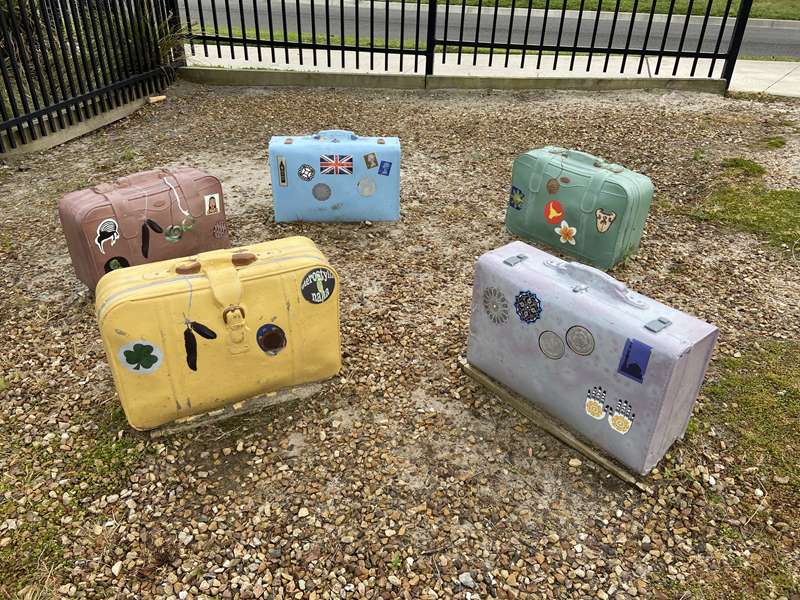
The suitcases represent the population of Cranbourne West. The cases are grouped together in ever larger groupings to show how the culture of the area has expanded to embrace the many people who have come to call Cranbourne West home. In each grouping there is a suitcase representing the traditional owners of this area, the Bunurong people.
On each suitcase is a baggage tag or sticker symbolizing the Cranbourne West's many cultures. The symbols range from items present in folklore to identifiable cultural symbols. For the Bunurong, Waarn, the black crow, was the keeper of the waterways, he is represented here with black feathers on each of the Bunurong cases.
In our lifetimes we all travel, whether it is geographically, emotionally or spiritually. These suitcases represent the journeys of those from nearby and around the world.
Location: Cranbourne West Family and Community Centre, Bradman Avenue, Cranbourne West
Dreaming Tracks

This series of 16 panels depicts the Indigenous history of the Cranbourne area. This is a shared area between two groups of the Kulin Nation - the Boon wurrung / Bunurong and the Wurundjeri. The 'Dreaming Tracks' are all interlinked by all aspects of Indigenous culture. The three Tracks represent the 'Land', 'Earth' and 'Sky'. The two linear Tracks use Victorian Indigenous symbology unique to this part of the State. Circles have been used to represent water which is a common symbol throughout Indigenous Australia.
Panels cover kangaroo & emu, cycles of culture, scar tree - shields, eel harvesting, gatherings, murnong (yam daisy), welcoming fire and smoking ceremony.
Location: 1I Everlasting Boulevard, Cranbourne West
Faster, Higher, Stronger by Damien Vick (2019)

'Faster, Higher, Stronger' is a sculpture that celebrates the courage of an individual's efforts to break their own personal best.
"While our society often demonstrates an obsession with winning through the idolization of the sporting elite, this work is an effort to recognize the little acts of heroism and determination achieved every day by those who simply strive to improve." - Damien Vick.
Location: 21 Quist Parade, Cranbourne West
Doveton
Rowan Park Mural (2014) by Bonsai, Twoone & Ghost Patrol

The Rowan park mural features a selection of spray painted animals and characters set in a bright coloured, gradient background that highlights and compliments the local parklands and landscapes.
Location: Rowan Park Reserve, 148 Kidds Road, Doveton
Thrones of Youth by Anuradha Patel (2008)

These vibrant seats celebrate the young people of Casey. Over a three year period, 32 young people worked with the artist in all processes of the artwork from the initial research and design to final completion and installation of three seats. The seats were unveiled during National Youth Week in 2008.
Location: Autumn Place, Doveton (west of Doveton library)
The Fantastic Friends of Autumn Place by Andrew Poppleton (2017)
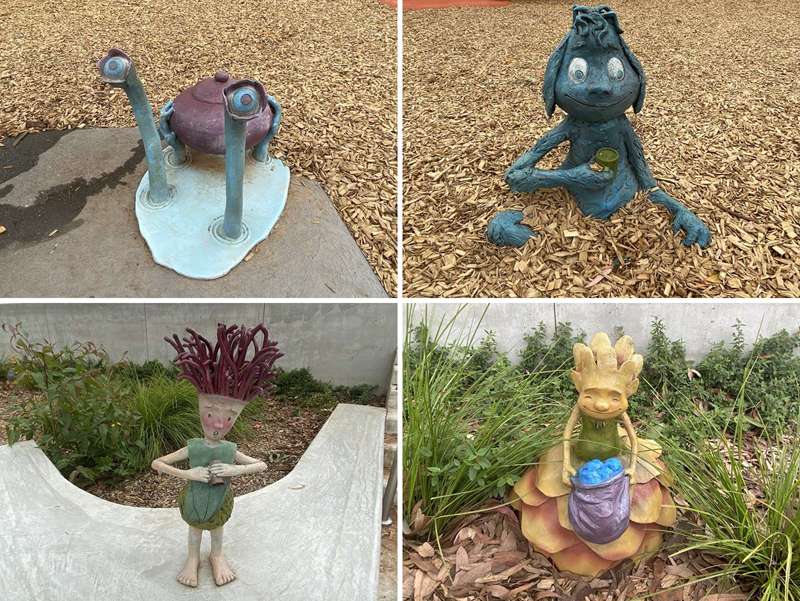
Five bronze sculptures depicting characters from the children's book "The Fantastic World of Autumn Place" by Dan Nixon and Simon Howe set in a playground.
Location: 29 Autumn Place, Doveton (within the playground area)
Endeavour Hills
The Whale Tale by Cameron Robins & Anderson Hunt (2000)

Artist, Anderson Hunt from Down Street Studios, worked collaboratively with students from Eumemmerring Secondary College to develop this sculpture for the Endeavour Hills Library. Themes of Captain Cook's boat 'The Endeavour', acknowledgment of the original owners of the land and reconciliation formed the basis for the overall design and the embedded images which were created by the students.
Location: Endeavour Hills Leisure Centre, 10 Raymond McMahon Boulevard, Endeavour Hills
Endeavour Hills Gymnastics Hall Facade by Julie Squires
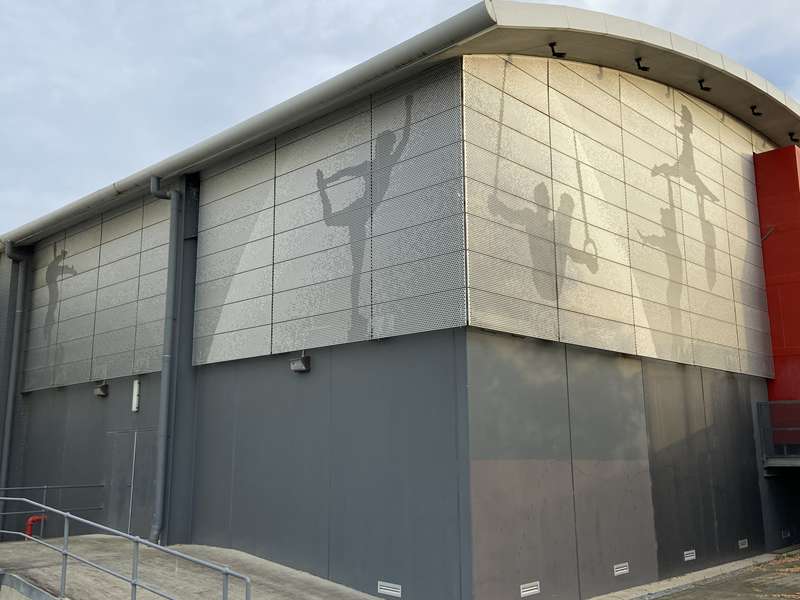
The Endeavour Hills Facade is designed to evoke and inspire the energy and physical grace encouraged within the centre. It is an image that captures the contemporary nature of the new architectural vision whilst reflecting the geometric form of the original facility. The curved graphic background is inspired by the local landscape and hills.
Location: Endeavour Hills Leisure Centre Gymnastics Hall, 10 Raymond McMahon Boulevard, Endeavour Hills
We are the Frog Hollow Frogs

What better sound than a chorus of us at night. We have survived both the Ice Age & the Dinosaurs, but in the last 30 years our numbers have declined alarmingly.
(1) I am the Eastern Brown Froglet (Crinia Signiferna). I am only 30mm long. There are lots more like me here, & we love to play in the boggy banks. I even jump into nearby fish ponds.
My colour: I have a dark brown back, light brown sides with a stripe seperating the two. My belly is very dark. My friends do vary a bit. I call: "crick-crick-crick"
(2) I am the Striped Marsh Frog (Limnodynasyes Peronii). My friends can be found right along the East Coast, I prefer the dense reed growth where I hunt flying insects. I am 67mm long.
My colour: Light brown / grey with a white stripe from my nose to my tail. My belly is white. I call: "Tok Tok" just like hitting a tennis ball.
(3) I am the Eastern Banjo Frog (Limnodynastes Dumerilii) I am the most common & the biggest. I am 75mm long & often call from the riverbank or while partly submerged.
My colour: I am pale grey to olive green, with a pale raised stripe below my eye, I have a yellow groin & cream belly. I call: "Bonk Bonk" especially after rain.
Location: Frog Hollow Reserve playground, 148 David Collins Drive, Endeavour Hills
Hampton Park
Hampton Park Youth Mural by Adrian Doyle, Darcy Cavage, SEB Fransz & young people from the Hampton Park Youth Centre (2015)

This art work is the culmination of a number of workshops at the Hampton Park Youth Centre. Young people worked with professional artists from Blender Studios to realize their ideas onto the wall of the Youth Centre.
Location: Hampton Park Youth Centre, 22 - 26 Stuart Avenue, Hampton Park
Hampton Park Through The Ages Mural

This community mural depicts the history of Hampton Park and celebrates the cultural diversity that now exists. River Red Gums remain an integral part of the Hampton Park environment, regardless of the changing human landscape. This mural was created by artist Rob Matheson together with support from artists Adam Magennis, Jenny Saulwick, Beryl Wilson and Margaret Worn, as part of the Hampton Park Community Renewal program supported by the Victorian Government. More than 300 Hampton Park residents helped to create artwork. The mural was officially unveiled on 2 April 2011.
Location: Arthur Wren Hall, 22 - 26 Stuart Avenue, Hampton Park
Hampton Park East Kindergarten Murals

There are two murals on the exterior wall of the Hampton Park East Kindergarten. One is panted by the children while the other is constructed from colored circles of different shapes.
Location: Hampton Park East Kindergarten, 16-20 Stuart Avenue, Hampton Park
Faces of Australia - Pelican, Water Rat, Kookaburra, Praying Mantis by Rod Jones
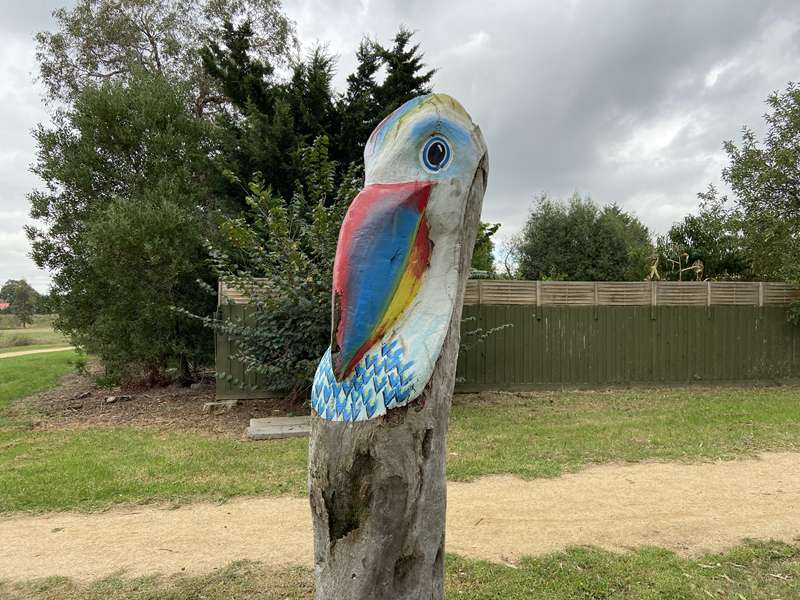
Carved timber and painted totem and information plaques in the shape of Australian creatures.
Location: River Red Gum Reserve , 25 Gandin Court, Hampton Park
Faces of Australia - Kanga, Koala, Platypus, Yabby, Wombat by Rod Jones
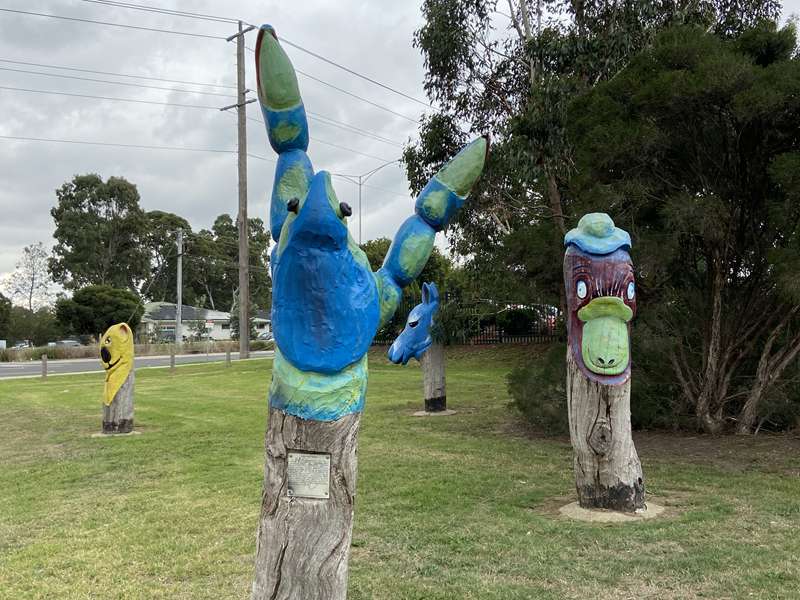
Carved timber and painted totem and information plaques in the shape of Australian creatures.
Location: River Red Gum Reserve, 50 Hallam Road, Hampton Park
Indigenous Medicine Wheel - Designed by Aiden Van Beek and the Koorie Youth Group - Hampton Park, Dandenong and surrounding areas Facilitated by Kerryn Knight (2013)
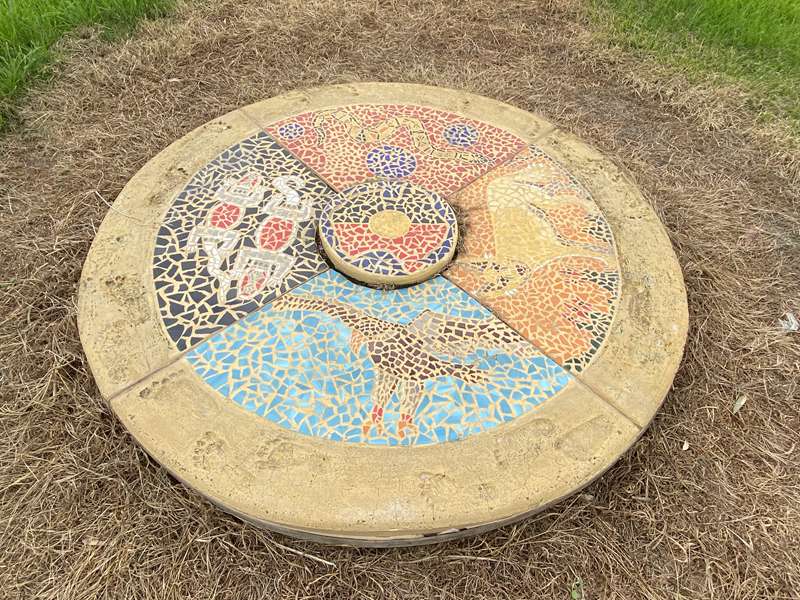
Walk the Medicine Wheel and learn about the Seasons of Life through Aboriginal Totem Animals - Through education comes understanding, through understanding comes unity -
NORTH - Your journey starts in the North with 'Bunjil' the Aboriginal Creator and Eagle Spirit of the Wurundjeri and Bunurong people of the Kulin Nation where you have visited today 'Bunjil' looks ahead with a bird` eye view of the journey that awaits you. With creativity and vision, you plan your path ahead.
EAST - Next you make your way to the East with the Goanna Footprints are bigger now The path is not always easy and the Goanna learns stillness and dignity in the face of difficulty Through courage, strength and endurance it succeeds and grows. So too, you learn, succeed and grow on your journey.
SOUTH - Then you continue to the South where the Snake sheds it's skin You, like, the Snake make changes in your life, letting go of things not needed to continue on your journey and make way for the new.
WEST - Continuing on, you travel to the West where the Mother Dingo awaits you. She helps you embody the changes you have made on your journey making you a whole new person through your gained awareness and wisdom.
CENTRE - And then you return home to your centre for healing and rest awhile in your new skin. You then look to the path again to lead you on your next journey, and so continues the Seasons of your life.
Location: 91 Coral Drive, Hampton Park
Lynbrook
The Mirror by David Forbes
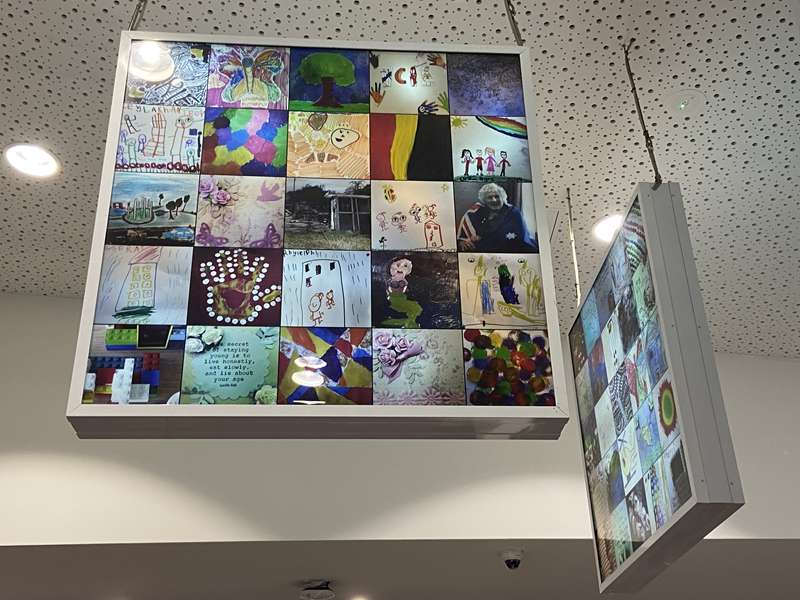
This work is a compilation of a range of diverse visual interpretations of the Lynbrook community. We invited individuals who will be using the new Lynbrook Community Centre on a regular basis to each produce a small image.
Location: Lynbrook Community Centre, 2 Harris St, Lynbrook
A Better View Sculpture by Mike Nicholls (2006)
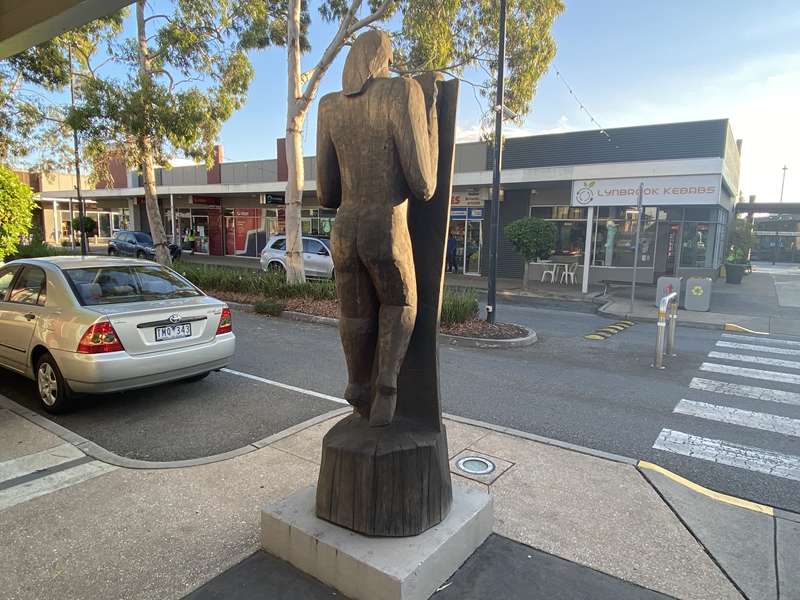
Location: Lynbrook Village Shopping Centre, Main Street, Lynbrook
Tree Hugger Sculpture by Stephen King (2006)
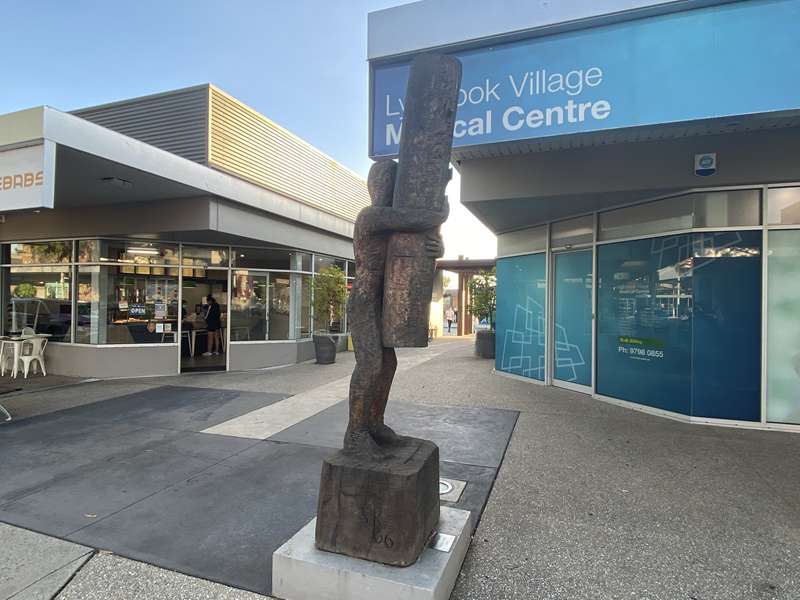
Location: Lynbrook Village Shopping Centre, Main Street, Lynbrook
Seed 1 Sculpture by Robert Bridgewater (2006)
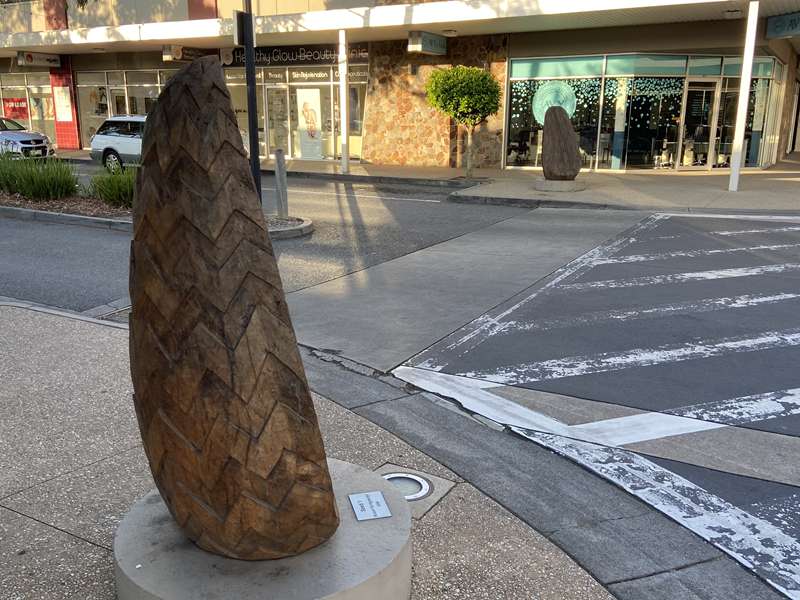
Location: Lynbrook Village Shopping Centre, Cnr High Street and Main Street, Lynbrook
Seed 2 Sculpture by Robert Bridgewater (2006)
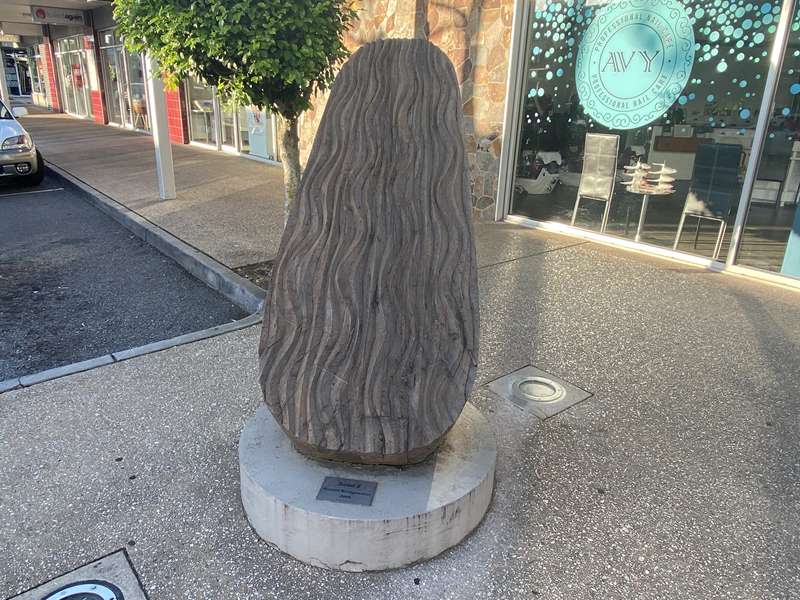
Location: Lynbrook Village Shopping Centre, Cnr High Street and Main Street, Lynbrook
Lyndhurst
Marriott Waters Play Space Bird Sculptures

The man-made wetlands area which is part of the Villawood Marriott Waters estate has an extensive range of large sculptures of birds including pelicans, storks and sea-eagles.
Location: Marriott Boulevard, Lyndhurst
Livvis Place Playspace Sculptures

Location: Boland Drive, Lyndhurst
'Touch' by Paul D Johnson (2013)

This sculpture alludes to the energy and movement in the nearby sport fields. The two arcs describe enormous energy meeting at a point of compressed power. The shapes also echo the oval grounds nearby while framing the landscape. The plasma-cut drawings are replicas of sport themed drawings provided by children from the City of Casey.
Location: Marriott Waters Recreation Reserve, Boland Drive, Lyndhurst
Aqua Evolution Sculpture by Folko Kooper
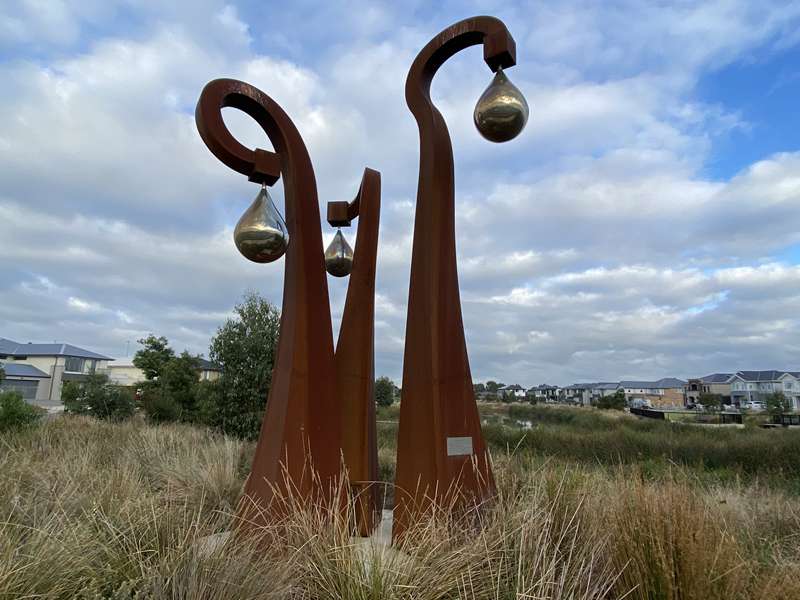
This sculpture is representative of the three types of water used in homes at Aquarevo:
- 3 drops of precious water - rain, drinking, recycled
- 3 pillars of steel representing Aquarevo's forward thinking partners - Villawood Properties, South East Water, City of Casey
Location: Cnr Rainwater Drive and Everspring Drive, Lyndhurst
Raindrops Sculptures by Folko Kooper
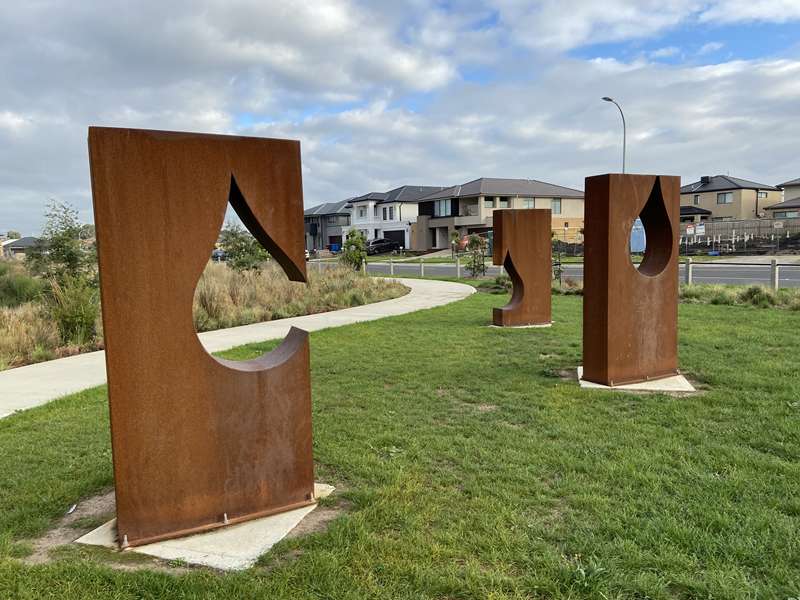
Location: Cnr Rainwater Drive and Conservation Drive, Lyndhurst
Yellowgum Avenue Eye Sculpture
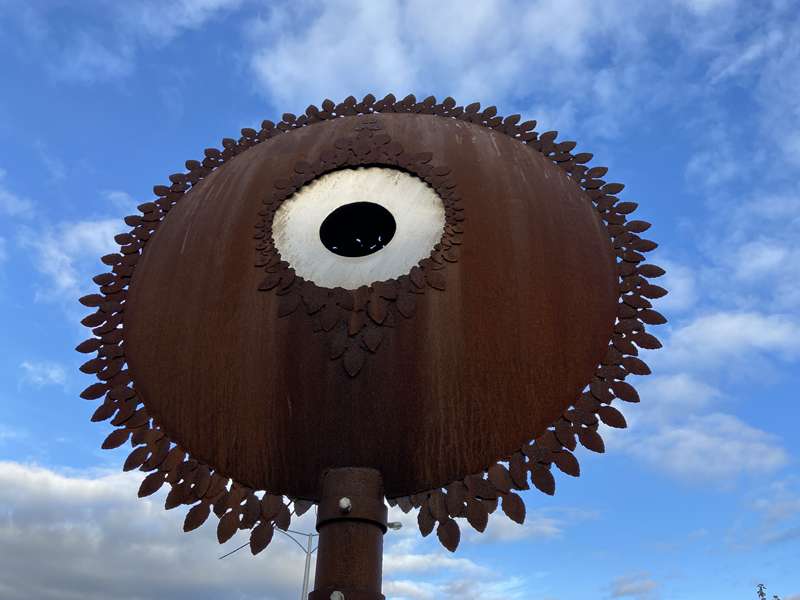
Location: Next to playground at 16 Yellowgum Avenue, Lyndhurst
Narre Warren
Commonwealth Games Leatherback Turtle by Mothers Art

As part of the spectacular opening on the 2006 Commonwealth Games in Melbourne, 72 fish sculptures were set on the Yarra River. Each fish represented a competing nation. Three of these fish were gifted to the City of Casey by the City of Melbourne and the Victorian Government and have now been restored for permanent display.
Location: Outside Casey ARC, Magid Drive, Narre Warren
Switch Restaurant Wall by Adnate, Slicer, Bryan Itch, Deams, Lucy Lucy

The theme of this mural is centred around sleep and subconscious activity. It captures the transition from conscious to unconscious realities and experiences.
Location: Switch Lifestyle Fountain Gate Restaurant, Magid Drive, Narre Warren (opposite Bunjil Place)
Fun Family and Friendship by Jenny Steiner (2011)
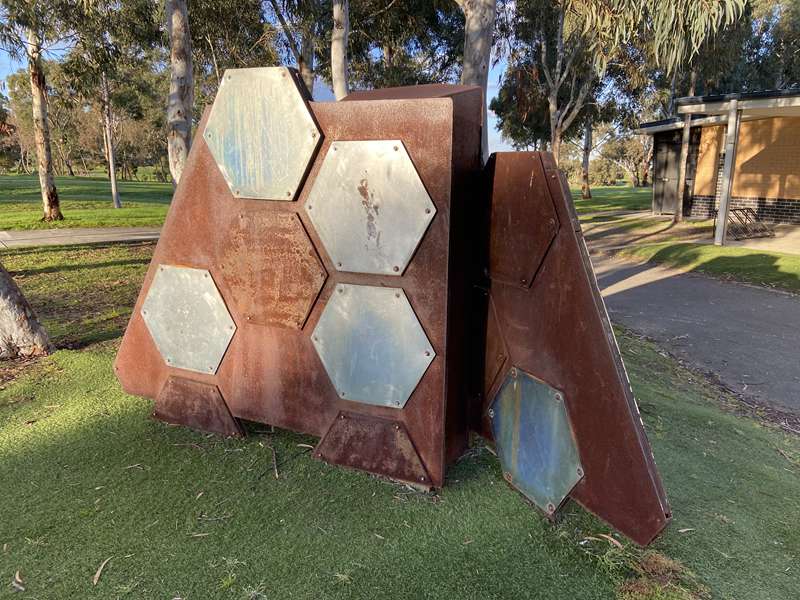
This artwork celebrates the community connections made by participants and families at the Prospect Hill Junior Soccer club. Assembled from a variety of treated steels pieces and influenced by the mathematical design of a soccer ball, the work includes etched images of the club members during play.
Location: Prospect Hill Recreation Reserve, 75 Kurrajong Road, Narre Warren
Webb Street Corner Mural by George Rose
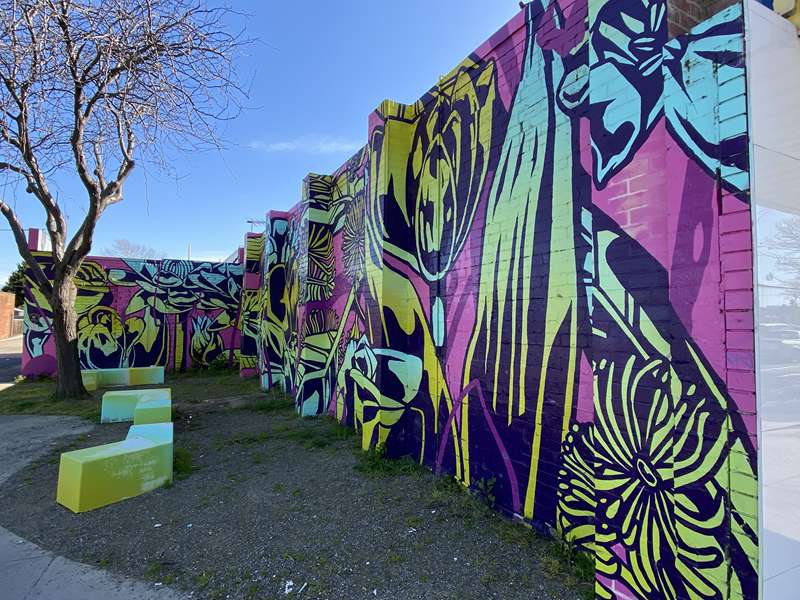
The City of Casey presents this mural with symbolic reference to the cultural diversity of Narre Warren through botanicals. Afghanistan: Tulip, Australia: Gum inflorescence, China: Plumb Blossom, England: Tudor Rose, India: Lotus, Sri Lanka: Blue Water Lily.
Location: 41 Webb Street, Narre Warren
Narre Warren Newsagency Mural by George Rose
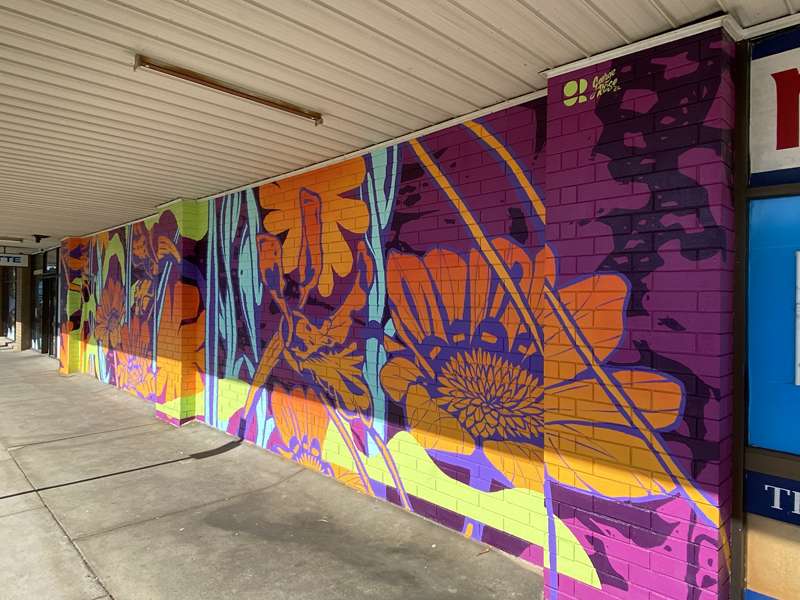
The artwork celebrates Narre Warren's natural environment with a particular focus on endemic florals found within the suburb - the Oleria Asterotricha and the Diuris Punctata - which are native to the Gippsland Plains. Both of these plants are rare, but species can be found within 5km of the mural.
Location: Narre Warren Newsagency, 34 Webb Street, Narre Warren
Wave of Learning Mural by Jenny Saulwick Community Artist (2004) and Anthea Welsh Project Officer

Location: Rear Narre Warren Opportunity Shop, 4 Malcolm Court, Narre Warren
Narre Warren North
Pride and Passion by Jenny Steiner (2009)
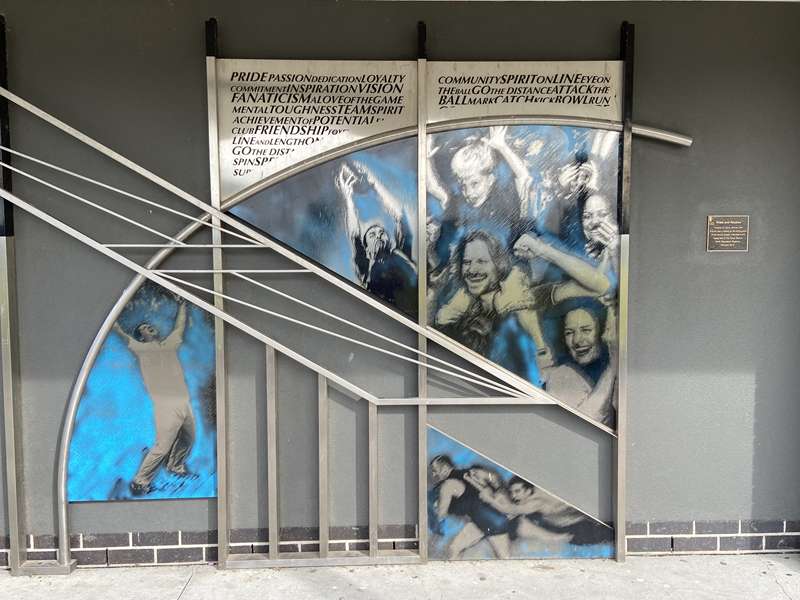
Celebrating community sports, this artwork reflects the pride and passion of players, supporters, club members, families, friends and supporters who turn out every week to urge their team on. This crafted stainless steel artwork combines the dynamic elements of sport such as the arc of the ball, dimensions of the pitch and vertical goal posts with finely etched images. Laser cut words capture the expressions of some of the community users of the reserve when talking about their sport.
Location: Narre Warren North Recreation Reserve Pavilion, 203a Belgrave-Hallam Road, Narre Warren North
Narre Warren South
Rebound by Grant Finck (2010)
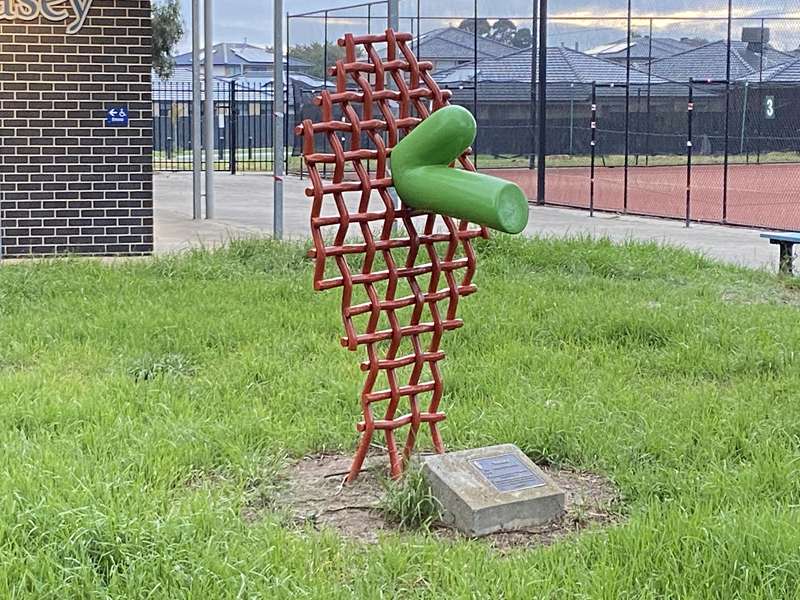
The concept for this artwork was developed with members of the Narre Warren South Tennis Club. Enjoyed by the visitors to the centre as part of tennis week activities. Composed of steel and resin, the work captures the moment in time when a tennis ball hits a racquet and rebounds.
Location: Narre Warren South Tennis Club, School Court, Narre Warren South
Amberly Park Drive Reserve Totem Poles
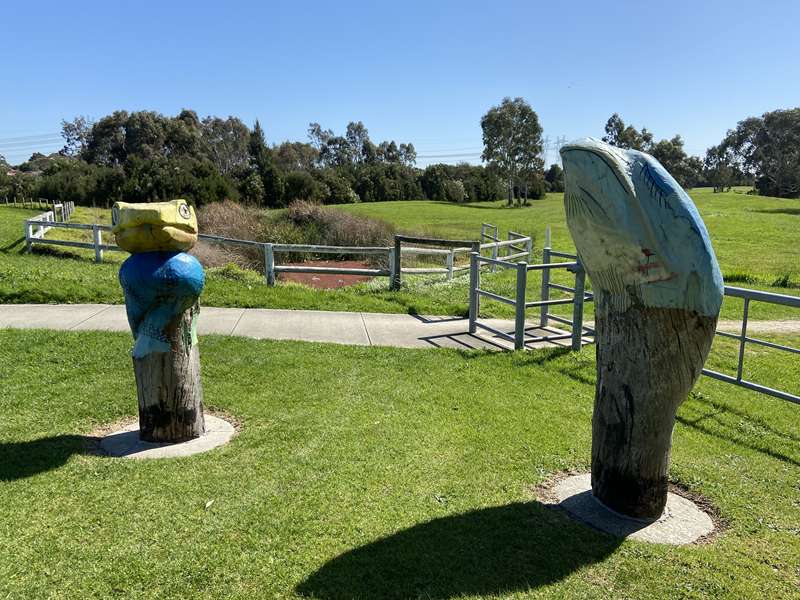
Carved timber and painted totem poles of creatures.
Location: Amberly Park Drive Reserve, Amberly Park Drive, Narre Warren South
Oakgrove Drive Totem Poles
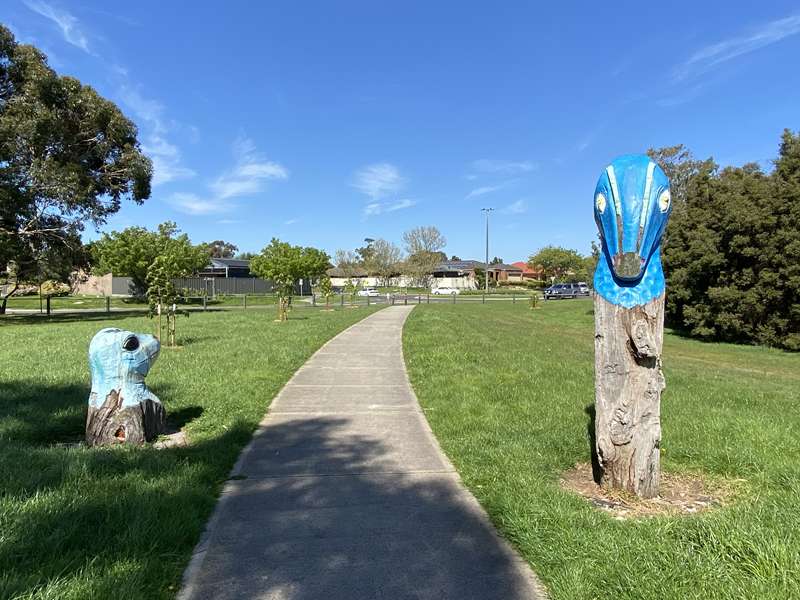
Carved timber and painted totem poles of dinosaurs.
Location: Cnr Oakgrove Drive and Addllington Court, Narre Warren South
Tooradin
Commonwealth Games Dolphin Fish by Mothers Art (2008)

As part of the spectacular opening on the 2006 Commonwealth Games in Melbourne, 72 fish sculptures were set on the Yarra River. Each fish represented a competing nation. Three of these fish were gifted to the City of Casey by the City of Melbourne and the Victorian Government and have now been restored for permanent display.
Location: Outside the Tooradin Hotel, Sth Gippland Hwy, Tooradin








